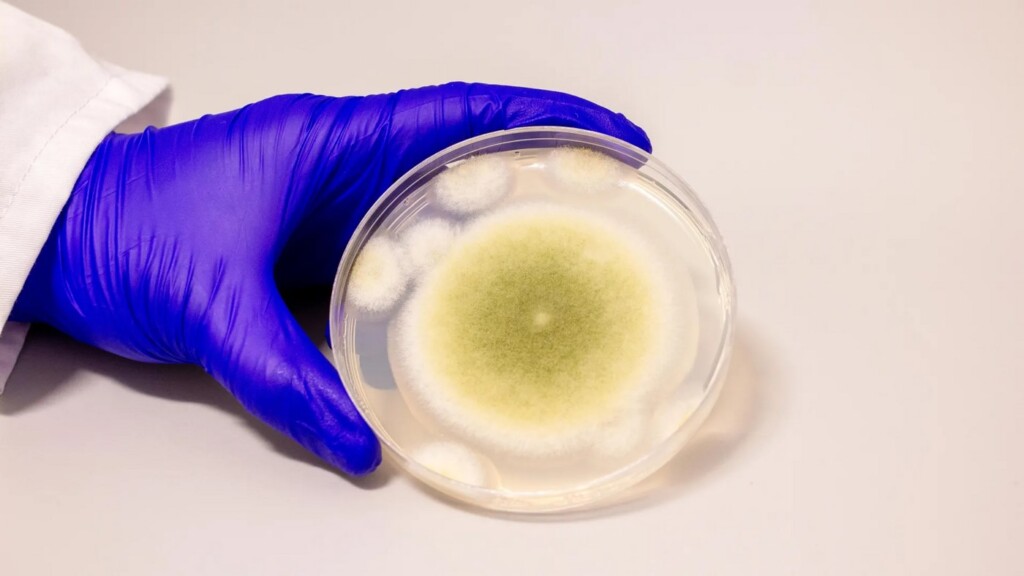 A sample of Aspergillus flavus cultured in the Gao Lab. Credit: Bella Ciervo, via Univ. of Penn State
A sample of Aspergillus flavus cultured in the Gao Lab. Credit: Bella Ciervo, via Univ. of Penn StateA deadly fungus has been turned into a potent cancer-fighting compound after researchers isolated a new class of molecules from it.
Aspergillus flavus, a toxic crop fungus linked to deaths in the excavations of ancient tombs—such as that of the boy pharaoh Tutankhamon—was recently used in a test against leukemia cells.
The result? A promising cancer-killing compound that rivals FDA-approved drugs and opens up new frontiers in the discovery of more fungal medicines.
“Fungi gave us penicillin,” says Sherry Gao, Presidential Compact Associate Professor at the University of Pennsylvania and senior author of a new paper in Nature Chemical Biologyon. “These results show that many more medicines derived from natural products remain to be found.”
After archaeologists opened King Tutankhamun’s tomb in the 1920s, a series of untimely deaths among the excavation team fueled rumors of a pharaoh’s curse. Decades later, doctors theorized that fungal spores, dormant for millennia, could have played a role.
In the 1970s, a dozen scientists entered the tomb of Casimir IV in Poland. Within weeks, 10 of them died. Later investigations revealed the tomb contained Aspergillus flavus, named for its yellow spores, whose toxins can lead to lung infections, especially in people with compromised immune systems.
Now, that same fungus is the unlikely source of a promising new cancer therapy.
The therapy in question is a class of ribosomally synthesized and post-translationally modified peptides, or RiPPs, pronounced like the “rip” in a piece of fabric. The name refers the ribosome, a tiny cellular structure that makes proteins, including RiPP.
“Purifying these chemicals is difficult,” says Qiuyue Nie, a postdoctoral fellow and the paper’s first author. While thousands of RiPPs have been identified in bacteria, only a handful have been found in fungi. In part, this is because past researchers misidentified fungal RiPPs as non-ribosomal peptides and had little understanding of how fungi created the molecules.
“The synthesis of these compounds is complicated,” adds Nie. “But that’s also what gives them this remarkable bioactivity.”
To find more fungal RiPPs, the researchers first scanned a dozen strains of Aspergillus, which previous research suggested might contain more of the chemicals. By comparing chemicals produced by these strains with known RiPP building blocks, the researchers identified A. flavus as a promising candidate for further study.
Genetic analysis pointed to a particular protein in A. flavus as a source of fungal RiPPs. When the researchers turned the genes that create that protein off, the chemical markers indicating the presence of RiPPs also disappeared.
This novel approach of combining metabolic and genetic information not only pinpointed the source of fungal RiPPs in A. flavus but could be used to find more fungal RiPPs in the future.
After purifying four different RiPPs, the researchers found the molecules shared a unique structure of interlocking rings. The researchers named these molecules, which have never been previously described, after the fungus in which they were found: asperigimycins.
Even with no modification, when mixed with human cancer cells, asperigimycins demonstrated medical potential: two of the four variants had potent effects against leukemia cells.
OTHER GIFTS FROM THE WORLD OF FUNGI: Ingredient Found in All Mushrooms Can Reprogram Immune Cells to Fight Deadly Flu Infections
Another variant, to which the researchers added a lipid, or fatty molecule, that is also found in the royal jelly that nourishes developing bees, performed as well as cytarabine and daunorubicin, two FDA-approved drugs that have been used for decades to treat leukemia.
Inside the leukemia cells, a gene called SLC46A3, proved critical in allowing asperigimycins to enter leukemia cells in sufficient numbers, which has given the team the idea that it might be a pathway for other, already developed remedies called cyclic peptides, to enter and kill a leukemia cell.
“Knowing that lipids can affect how this gene transports chemicals into cells gives us another tool for drug development,” says Nie.
Through further experimentation, the researchers found that asperigimycins likely disrupt the process of cell division. Notably, the compounds had little to no effect on breast, liver or lung cancer cells, or a range of bacteria and fungi, suggesting that asperigimycins’ disruptive effects are specific to certain types of cells, a critical feature for any future medication.
NOVEL CANCER TREATMENTS: Scientists Identify New Way Cancers Sustain Themselves–and How Ginger Could Disrupt it
In addition to demonstrating the medical potential of asperigimycins, the researchers identified similar clusters of genes in other fungi, suggesting that more fungal RiPPs remain to be discovered.
“Even though only a few have been found, almost all of them have strong bioactivity,” says Nie. “This is an unexplored region with tremendous potential.”
“Nature has given us this incredible pharmacy,” says Gao. “It’s up to us to uncover its secrets. As engineers, we’re excited to keep exploring, learning from nature and using that knowledge to design better solutions.”
SHARE This Wild And Expected Place To Find A Potential Cancer Cure…
Source link

